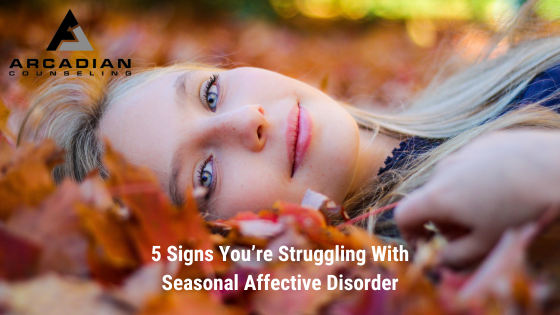As the seasons change and the days grow shorter, a lot of folks find themselves grappling with changes in mood and energy. For some, this seasonal shift goes beyond a simple case of the winter blues – it could be something that affects roughly 5% of the population: Seasonal Affective Disorder (SAD).
Seasonal Affective Disorder is a type of depression that usually shows up during the fall and winter months when daylight becomes scarce. Recognizing the signs of seasonal affective disorder early is vital for managing the impact on your mental well-being.
Four out of five people who have Seasonal Affective Disorder are women and the further you live from the equator, they higher the prevalence. So if you’re among the 60% of Americans who live where it snows, it’s a good idea to know the signs and symptoms so you can better manage them.
5 signs you might have seasonal affective disorder
1. Persistent Low Mood

A pervasive and persistent low mood is often the first telltale sign of Seasonal Affective Disorder. If you feel like you’re constantly navigating through days overshadowed by a cloud of sadness while experiencing a lack of interest or pleasure in activities you once relished, you might be struggling with Seasonal Affective Disorder.
Unlike the occasional emotional roller-coasters we all ride from time to time, the key characteristic with Seasonal Affective Disorder is the prolonged nature of the low mood that persists for most of the day and for most days during the “winter” months.
SAD can make even the simplest tasks feel like insurmountable challenges, and the gloominess seems to cling to you, polluting your overall perspective on life.
2. Changes in Sleep Patterns

Another big indicator of Seasonal Affective Disorder is disruptions in sleep patterns. If you notice a shift in your sleeping habits, such as sleeping excessively, struggling to get out of bed in the morning, or facing difficulties falling asleep at night, it could be linked to SAD. The lack of exposure to natural sunlight during the darker months can disrupt the body’s circadian rhythm, leading to these sleep disturbances.
Conversely, some individuals may experience hypersomnia, finding solace in extended hours of sleep but still waking up feeling fatigued. These changes not only impact your rest but contribute to the overall sense of lethargy and fatigue that often accompanies Seasonal Affective Disorder.
3. Weight Changes and Appetite Disturbances

Seasonal Affective Disorder can also manifest in fluctuations in weight and disturbances in appetite. Some individuals may notice an increased craving for carbohydrates, particularly sugary and starchy foods, leading to weight gain. This craving is often a result of the body’s attempt to boost serotonin levels, a neurotransmitter associated with mood regulation.
On the other end of the spectrum, some people might experience a loss of appetite, leading to unintended weight loss. These shifts in eating habits can become a complex interplay between emotional well-being and physical health, further emphasizing the multifaceted nature of Seasonal Affective Disorder.
4. Low Energy Levels and Fatigue

A pervasive sense of fatigue and low energy levels is a hallmark symptom of Seasonal Affective Disorder. Even with an adequate amount of sleep, individuals with SAD may find themselves struggling to muster the energy needed to tackle daily tasks. Simple activities that were once effortless may now feel like monumental challenges.
The fatigue associated with Seasonal Affective Disorder is not solely physical – it permeates into the emotional and cognitive realms, impacting concentration, motivation, and the ability to engage with the world. This persistent weariness can lead to a diminished quality of life and hinder personal and professional pursuits.
5. Social Withdrawal and Isolation

As Seasonal Affective Disorder takes hold, a desire to withdraw from social activities and isolate oneself often follows. If you find yourself shying away from social interactions, opting to spend more time alone, it could be an indicator of the impact of SAD on your mental well-being. The emotional weight of this condition can make socializing feel like an arduous task, leading to a sense of isolation and loneliness.
This withdrawal from social connections further exacerbates the challenges associated with Seasonal Affective Disorder, as social support is a crucial element in managing mental health. Recognizing this sign early on can prompt individuals to seek the support they need and break the cycle of isolation.
Seasonal Affective Disorder is often more than just a case of the winter blues; it’s a complex form of depression that often requires attention and support. Recognizing the signs – persistent low mood, changes in sleep patterns, weight changes, low energy levels, and social withdrawal – is the first step toward seeking the help needed to navigate through the challenging winter months.
Life is short, but Seasonal Affective Disorder isn’t. If you’re struggling with these signs, find an awesome therapist you like and trust to help you feel like your best self so you can live your best life!
James Killian, LPC is the Principal Therapist & Owner of Arcadian Counseling in Greater New Haven, CT where they specialize in helping over-thinkers, high achievers, and perfectionists reduce stress, increase fulfillment and enhance performance so they can move From Surviving To Thriving.

